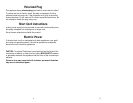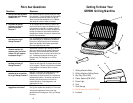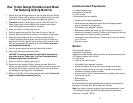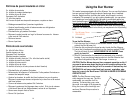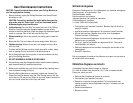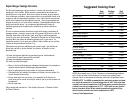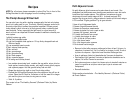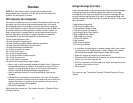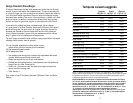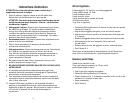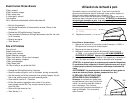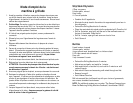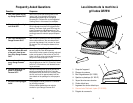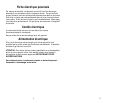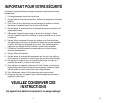
9
12
Temps de cuisson suggérés
Saignant À point Bien cuit
145˚F (63 °C)* 160˚F (71 °C)* 170˚F (77 °C)*
Filet de saumon 2
1
/
2
min. 3 min. 4
1
/
2
min.
Darne de saumon 4 min. 6 min. 10 min.
Espadon 7 min. 9 min. 10 min.
Darne de thon 6 min. 8 min. 10 min.
Poisson à chair blanche 4 min. 5
1
/
2
min. 7 min.
Crevettes 1
1
/
2
min. 2
1
/
2
min. 3
1
/
2
min.
Steakette de dinde 113 g 5 min.
Steakette de dinde 227 g 6 min.
Longe de porc 5 min. 6 min.
Hamburger 113 g 7 min. 8 min. 9 min.
Hamburger 227 g 8 min. 9 min. 10 min.
Poitrine de poulet (désossée, sans peau) 9 min.
Petites saucisses 4 min. 5 min.
Saucisse en tranches (2 cm d’épaisseur)
6 min. 7 min.
Boeuf au Fajita (1,3 cm d’épaisseur) 1
1
/
2
min. 2 min. 2
1
/
2
min.
Bifteck d’aloyau 8 min. 9 min. 10 min.
Bifteck de NY 4 min. 7 min. 10 min.
Bifteck de flanc 7 min. 8 min. 10 min.
Oignons et poivrons (à l’huile d’olive) 8
1
/
2
min.
NOTE : La plupart des viandes avaient 2,5 cm (1 po) d’épaisseur. Ces données sont
fournies à titre indicatif seulement. Les temps de cuisson peuvent varier selon vos goûts
et l’épaisseur des aliments. Assurez-vous toujours qu’ils soient suffisamment cuits et
n’utilisez que des aliments frais et correctement réfrigérés.
NOTE IMPORTANTE : Pour éliminer le risque d’infection bactérienne due à la Listeria
ou à l’E-coli, Santé Canada recommande de bien cuire la volaille et la viande de bœuf,
de porc, d’agneau, etc. Utilisez un thermomètre à viande pour vérifier que la viande et
la volaille ont atteint la bonne température interne. Le poulet entier et les morceaux
doivent être cuits à 82 °C - 85 °C (180 °F - 185 °F) et les morceaux de dinde à 77 °C (170
°F). Le bifteck et le rosbif doivent être cuits aux températures suivantes :
demi-saignant, à 63 °C (145 °C); à point, à 70 °C (160 °F); bien cuit, à 75 °C (170 °F). Les
côtelettes et côtes de porc doivent être cuites à 70 °C (160 °F ). Les viandes hachées
doivent atteindre une température de 71 °C (160 °F).
* Température interne des aliments
George Foreman’s PowerBurger
A flavorful hamburger that we think tastes even better than its all-meat
cousin! It pays to eat meals that minimize meat. To reduce saturated fat
in a typical burger, you can cut back on the amount of meat and make up
for it with plant-based ingredients. Bread crumbs and chopped vegeta-
bles have been added in this recipe. You could also try cooked rice, other
grains or cereal. In addition, choose whole wheat buns; they typically
contain one less fat gram than regular or even reduced-calorie buns.
If you settle for nothing less than a cheeseburger, Swiss cheese
is 1 gram lower in fat than Cheddar, American or Monterey Jack with 8
grams of fat versus 9 in each ounce of cheese. However, reduced fat
cheeses like Cheddar or Swiss contain half the fat with 4 grams per
ounce. Mustard contains 1 gram of fat per tablespoon versus a whop-
ping 11 grams of fat in a tablespoon of mayonnaise.
Top your burger in healthful style with dark, leafy green lettuce, shredded
cabbage, fresh cilantro, basil or spinach.
1/4 cup chopped vegetables such as yellow onions,
green onions, zucchini, parsley (can be sautéed)
1/4 cup seasoned bread crumbs
3/4 lb. lean ground beef
• In a medium-size mixing bowl, combine the vegetables and bread
crumbs. Add the ground beef and mix well.
• Shape the mixture into four 4-inch wide patties.
• Preheat the Grilling Machine for 5 minutes and place the patties on
the grill two at a time. Close the Lid.
• Cook for 8 - 9 minutes or until the meat is no longer pink and the
juices run clear, turning once.
• Yield: Serves 4
This recipe is from "The Healthy Gourmet" (Clarkson Potter) by Cherie
Calbom.



